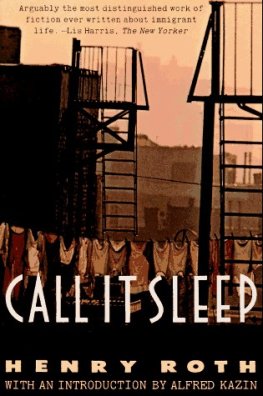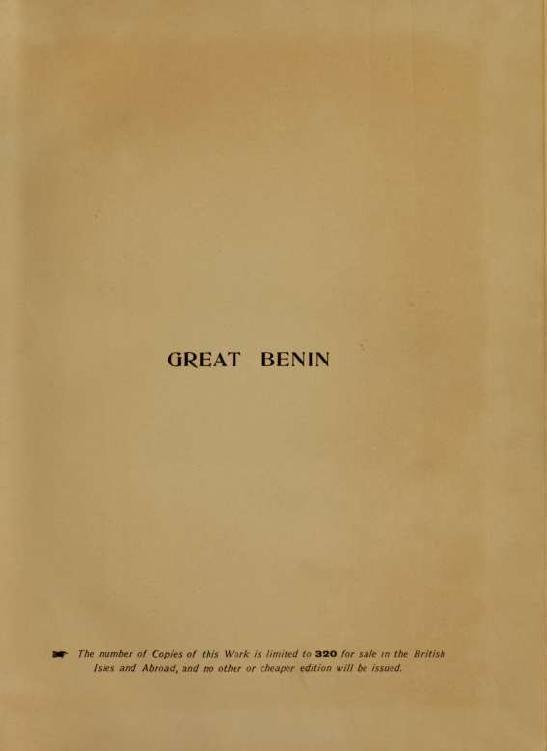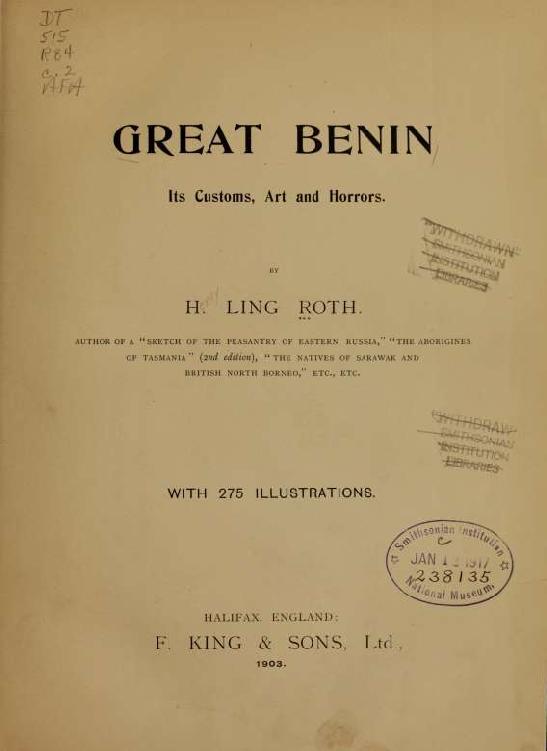This book made available by the Internet Archive.
PREFACE
At the time of the destruction of the city of Great Benin, we seemed to know very little about the city or the country, but its capture caused us to seek out what had once been known and long since forgotten. Our ignorance was due partly to the fact that Benin was, from the time of the first discovery, a decaying city off the great high-roads of European commerce, and partly to the obstacles placed in the way of Europeans getting there, by the natives, a difficulty in which the unhealthy nature of the country came to the aid of the blackman. The first Dutch chronicler tells us: "A man might write more about this town if he were allowed to see it, as you may our towns at home; but this is not permitted here, but is forbidden and prevented by one who is always given to attend upon you, to go with you, to show you the right way, so that no one is allowed to go alone through the town, which they say is because a stranger should not lose his way, but nevertheless one may not go boldly just as one pleases." And this prohibition with regard to the visits of Europeans continued in force until the very last. Whether such obstacles were due to the fear of the denunciation of human sacrifices and all their attendant horrors, or whether the ruling chiefs rightly feared that once a European got a footing he would soon become master of the country, as he has an awkward way of doing, matters little now; but if a city ever deserved its fate, that city was the city of Great Benin. At the same time, while we cannot avoid feelings of regret that an interesting old town and its old-world institutions should have been destroyed, the horrors which met the Punitive Expedition, when it entered the sacred precincts, showed that the little war we waged was justified beyond all expectation.
For an account of the impression the city produced on a European I cannot do better than quote the words of my friend Mr. Cyril Punch :
" Benin has an extraordinary fascination for me which I cannot explain. Having spent twenty years in the Niger Delta and Lagos back country, and visited most of the places from Bariba to Old Calabar, and surveyed them from the points of view of trader, planter, and official, I can remember no place which stirs up the feelings which the mention of Benin does. Looking back now, with later experiences of official visits to out of the way corners, with one's police or Haussa escort to take care of one, those wierd visits to Benin City simply stand by themselves.
"All the rest of West Africa that I know is s(iualid. Squalor is just the one idea that strikes one. Benin in the old days was more than squalid, it was gruesome. What the exact influence of the place was, or rather what the cause was of the influence felt, I cannot say, but the fact remains that no one who went there in the old days came away without being impressed.
" It may be that Benin, through foreign influence growing from a negro into a civilised town long ago and reverting to type, really gives the place its interest. One was always stumbling across traces of a deceased civilization akin to our own, yet nothing in negro nature is really akin to us.
" As a town, Benin was inconsiderable compared with places like Ibadan, Iseyhin, Shaki, Modakeke, and Abeokuta. There was no wealth, nor was there even power, except the power of the influence of fetish, and the sense of the spirit of a long past of atrocities, which, if not supernatural, were at any rate unnatural to a degree which is indescribable. I remember the return of two of Miller Brothers' men from a visit they paid to Benin after I had been there. They arrived at Guatun one evening, and showed plainly in their faces the mental strain that their visit had been to them."
In the preparation of this work I am indebted to Mr. C. H. Read for his courteous permission to make use of the exhibits in the British Museum for illustrations, and to the Council of the Anthropological Institute for the use of the blocks of the plaques in the British Museum, from the paper by Messrs. Read and Dalton in the Journal of that Institute. The photographs by Mr. Granville were kindly taken for me with a camera I supplied him with immediately after the war. To Mr. Heawood, Librarian of the Royal Geographical Society, I owe many thanks for assistance in hunting up the records of the French traders after the time of the Dutch. Dr. Forbes, Director of the Liverpool Museum, I have to thank for permission to illustrate some of the Bini articles under his care, and to Mr. J. Batalha-Reis, Portuguese Consul-General, I owe thanks for assistance in obtaining information from the old Portuguese chroniclers. To Mr. Jas. R. Boose, Librarian of the Royal Colonial Institute, Mr. John Holt of Liverpool, and Mr. Jas. Irvine of Liverpool, I likewise owe thanks for the loan of books. Most of all am I indebted to Mr. Cyril Punch, who has been so good as to revise the information I had collected, and who, besides supplying me with valuable notes and sketches, has at the same time allowed me to choose for publication some of the most interesting of the many photographs he had taken while in the Bini country. The reader will have no difficulty in gauging and appreciating the large amount of his assistance, which was given at all times frankly and cheerfully.
TO THE MEMORY OF A VERY DEAR FRIEND.
Contents.
IX
Medicine
Music and Games
CHAPTER XV CHAPTER XVI
CHAPTER XVH
The City and its Buildings
Carved Work
The Metal Castings
CHAPTER XVni
CHAPTER XIX
PAnK
APPENDICES I
The Treaty between the King of Benin and Capt. Gallwey,
D.S.O................ i
H
A Diary of a Surgeon with the Benin Punitive Expedition
BY F. N. Roth, M.R.C.S.......... ii
HI
The Surrender and Trial of the King
IV
Xll
On the British Loss of Antique Works of Art from Benin xviii
V
Land Tenure and Inheritance in Yoruba, by Cyril Punch
XXI
ILLUSTRATIONS.
Frontispiece - King Overami.
Fig. I. Bronze Plaque : European out Shooting
2. do. do. : Bearded European
3. do. do. : European armed with Matchlock
4. do. do. : European armed with Matchlock and Sword 5-7. Bronze Statuette: European Soldier, Sword and Rapier
8. D.R.'s Illustrations of Head Dressing
9. Coral Beads..
10. do. Bead Network Cap
11. do. do. Fly whisk ..
12. do. do. Apron
13. 14. Bronze Heads
Page.
8 8 9 9 10 18
19 20
22 23. 25
Fis:.
5^-
33-35
3S.
39-
41, 42.
43-45. 46
47. 48.
5^
6o
70 . ,
72-
73-
74-
77. 7S-
















